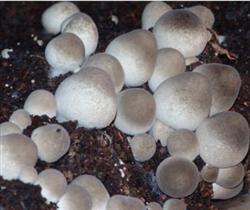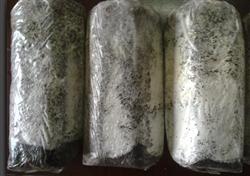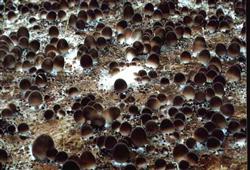Four measures to increase production of volvariella volvacea

In the process of volvariella volvacea growth, some appropriate measures can be taken to increase production. Secondary inoculation with primary and secondary inoculation is beneficial to the yield increase of volvariella volvacea. The mycelium of volvariella volvacea grows too fast and ages easily, which weakens its vitality and can not make effective use of the nutrients in the culture material to continue to produce mushrooms. After the first tide of mushroom harvest, pry loose the material surface, drench it thoroughly with lime water, adjust the pH value of the culture material to 8: 9, then sow the bacteria on the material surface, and cover a thin layer of fermented culture material after sowing. You can also turn the material block over after the first and second tide mushrooms are harvested, turn the bottom culture material to the surface, spray 1% lime water, replenish water, adjust the pH, and then inoculate the surface for a second time. The amount of inoculation is 2%-3%. Generally, the yield can be increased by about 30%. When straw mushroom is cultivated with rice straw, bacteria can be stuffed into the space between the grass layer 4 days after straw sowing, and the inoculation amount is about 20% of the first dosage. In this way, when the first tide of mushrooms is collected, the bacteria sown for the second time can be decomposed from the haystack, accumulate nutrients and continue to produce mushrooms. Second, adjusting acidity and alkalinity in the growth process of volvariella volvacea will consume a lot of nutrients and produce metabolites, in which organic acids can increase the acidity of culture materials and affect the normal recovery of straw mushroom mycelium and continue to produce mushrooms. After the first tide mushroom harvest, adding some nutrient solution and adjusting the culture material is slightly alkaline, which can promote the recovery of mycelium, prolong the mushroom harvest period and increase the mushroom yield. (1) spraying 3% lime water on the culture material can not only replenish the water, but also make the culture material slightly alkaline. (2) spray 0.1% urea and bran water on the culture material (100 kg of water plus 10 kg of wheat bran, boil and filter, take 50 kg of filtrate and 50 kg of water). The amount of urea is 0.1%-0.2%, and the dosage should not be too much, otherwise it is easy to produce miscellaneous bacteria. (3) to supplement dried cow dung and human urine. Break the dried cow dung, add 40% human urine, mix it well, pile it up for one day before use, and apply it to the noodles after picking a tide of mushrooms. If you add some chicken and duck dung, the effect will be better. Third, the implementation of soil mulching of volvariella volvacea can improve the moisturizing performance of the culture material and the ability to adapt to the change of humidity, enlarge the mushroom body, reduce the dead mushroom, and increase the yield by 20% to 40%. The covering material can be vegetable garden soil (dug below 8cm below the surface), and the thickness of the covering soil is generally 2 cm. Fourth, cover film straw mushroom after inoculation, cover with thin film around the bacterial bed, can increase and stabilize the material temperature, maintain humidity, increase the concentration of carbon dioxide in the microclimate around the material surface, promote the reproduction of relevant microorganisms, and promote the growth of straw mushroom mycelium. The film should be covered immediately after inoculation, sooner rather than later. In order to prevent the film from clinging to the material surface to affect the normal respiration of the bacteria, sprinkle some rice straw or wheat straw soaked in lime water on the material surface. After covering the film, we should pay attention to check the material temperature. If the material temperature exceeds 40 ℃, it is necessary to uncover the film in time to cool down. After covering the film for 4 days, the film should be ventilated regularly or set up with bamboo slices to prevent the surface hyphae from growing and affecting the extension of the hyphae into the material. When the mushroom bud appears, the covered film should be opened in time, or the film should be propped up to prevent the mushroom bud from being suffocated by hypoxia.
- Prev

Three ways to prevent the mycelial growth of volvariella volvacea
(1) the culture material should not be too wet and the water content should not exceed 70%. Choose appropriate ventilation at noon or afternoon when the temperature is low. (2) after spraying mushroom water, open the doors and windows or uncover the film for ventilation to reduce the material temperature properly, and then close the doors and windows or cover the film properly when there are no water droplets on the material surface. (3) planted with cottonseed hull or waste cotton.
- Next

What problems are often encountered in the cultivation of volvariella volvacea
1. The emergence of group mushroom sowing amount is too large, uneven sowing, will lead to the emergence of group mushroom. Therefore, the sowing rate should be controlled at 0.2-0.3 kg / m2. The sowing method can be layered sowing, mixed sowing or sowing, preferably without hole sowing. 2. Strain aging if the use of aging bacteria, although the germination of hyphae.
Related
- Fuxing push coffee new agricultural production and marketing class: lack of small-scale processing plants
- Jujube rice field leisure farm deep ploughing Yilan for five years to create a space for organic food and play
- Nongyu Farm-A trial of organic papaya for brave women with advanced technology
- Four points for attention in the prevention and control of diseases and insect pests of edible fungi
- How to add nutrient solution to Edible Fungi
- Is there any good way to control edible fungus mites?
- Open Inoculation Technology of Edible Fungi
- Is there any clever way to use fertilizer for edible fungus in winter?
- What agents are used to kill the pathogens of edible fungi in the mushroom shed?
- Rapid drying of Edible Fungi

